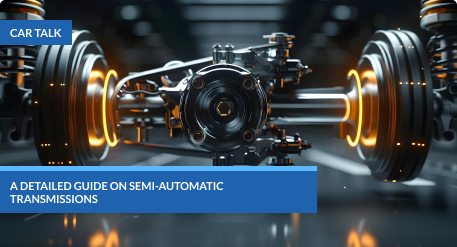In the modern car world, the majority of the cars that you see have automatic transmissions. Cars with automatic transmissions are easy to use, and you do not have to give much thought to shifting gears when driving, making these cars much more simple to drive. However, there are many other variants available in these cars. For example, cars with manual transmissions may not be as popular as automatic cars, but they offer great control over your driving and are also quite popular in European countries. Also, they can be purchased for a much cheaper price than automatic cars.
Along with automatic and manual transmission, there is another variant many people are unfamiliar with i.e., semi-automatic transmission. But what does semi-automatic transmission mean? It means that it contains functions from the both manual and automatic transmission. Lets dive deep into semi-automatic transmissions.
What is a Semi-Automatic Car?
Because of lesser demand, locating cars with semi-automatic transmissions may be challenging these days. However, these car models come with a dual clutch and automatic gearbox, allowing you to separate in both ways for better control and ease.
These cars have a transmission system with a gearbox without a clutch pedal. Meaning that you will not have to focus on engaging and disengaging the clutch when shifting gears. The only difference between manual and semi-automatic transmission is that it uses actuators and electronic components rather than physical ones such as cable, pipe, and gear shifting.
The top advantage of using this type of system is that it offers better fuel efficiency, and driving it is also easier than manual cars.
Working of Semi-Automatic Transmission
Different types of energies are used in semi-automatic transmission to propel the car and switch the gears proficiently.
Moreover, a clutch mechanism between the engine and the semi-automatic gearbox allows the gearbox to engage or disengage. The timing of the gearbox engaging and disengaging in semi-automatic transmission depends on the situation. It engages with the engine and disengages when it can easily spin without interference from the engine, showing its effectiveness and versatility.
In vehicles with manual transmission, this system utilizes a pedal to engage and disengage the clutch physically, allowing you to shift between the range of gears in your vehicle. This mechanism is quite different from semi-automatic transmission, where a set of actuators and a hydraulic motor are used instead of a clutch pedal and gear level.
In addition, in semi-automatic transmission, there is a computer that is in charge of changing and controlling actions in the car, including acceleration, the car’s speed, the torque, the accelerator pedal position, and other important components that ensure the safety and efficiency of a vehicle.
When the car’s computer determines the need to change the gears, it turns on or engages the clutch to disengage the semi-automatic transmission from the engine’s control. At this point, the clutch is disengaged, and actuators turn on the gear shifting.
What are the Benefits of Semi-automatic Transmission
- One of the prime advantages of the semi-auto gearbox is that it offers better fuel efficiency and is also easy to use as an auto gearbox.
- Shifting on a semi-automatic transmission offers a smooth driving experience.
- If you are learning to drive, using a semi-automatic transmission is preferable.
What are the Cons of Semi-Automatic Cars?
Some of the cons linked with semi-automatic cars include
- Requires more money to maintain a semi-automatic car than it does for a manual.
- A semi-automatic automobile is less expensive to replace than to fix.
- They have a history of failing and malfunctioning.
Cars that Have a Semi-Automatic Transmission
The semi-automatic transmission has been around since 1930. So, it is obvious that you will find this system in various old vehicles. However, some modern cars also use this transmission, such as
Opel
This company utilizes the Easytronic transmission in some of their vehicles, and you can find it in their smaller cars, such as Corsa.
The Corsa is a supermini car that was first produced in 1982. It is also called Vauxhall Corsa. This vehicle has a 5-speed manual, a 4-speed automatic, and a 5-speed semi-automatic transmission.
Ferrari
In 1993, the high-end carmaker employed an automatic gearbox in their Ferrari Mondial for the first time. The Ferrari 599 GTO is equipped with the most recent version. Then, in all of their subsequent models, the manufacturer decided to stick with a double-clutch transmission and kept experimenting with it.
Ford
The first semi-auto was introduced in the 1970 Maverick. This semi-auto car was without a self-shifting option, but the semi-automatic transmission option was later in production. Electronic and SelectShift transmissions are now available in recent cars, including Fiesta and Fusion.
Honda
The Honda vehicles with semi-automatic transmissions came to light in the early 1970s, making Honda an innovator and pioneer of this technology. The first semi-automatic vehicle Honda manufactured was the Hondamatic or H2.
Final Thoughts
Now you know what a semi-automatic car is and the benefits it offers when you drive it. These cars offer a mix of qualities of automatic and manual tranmsissions to offer a unique driving experience. Even though finding a semi-automatic vehicle can be a hassle, you can look into auctions and find a semi-automatic car.

